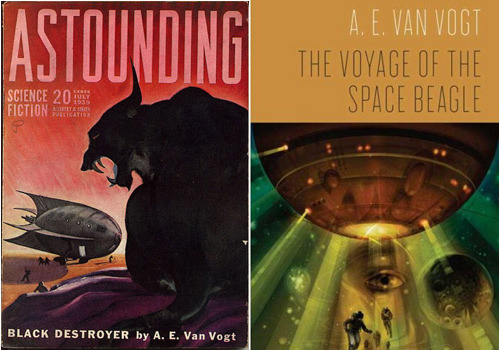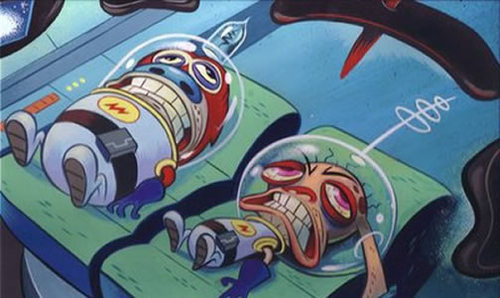THE VOYAGE OF THE SPACE BEAGLE by A.E. van Vogt
It's been a while since I bored into a book like a hopped-up literary woodpecker, so here's some brain spillage originally written last year and never posted. 
Left: "Black Destroyer," 1939
Right: Current edition from Orb Books.
Hot jets, Kinnison! What a jaunt in the way-back machine this is. I first became aware of The Voyage of the Space Beagle via Barlowe's Guide to Extraterrestrials as a kid, and once again waited a mere two decades before reading the source material. At this rate, I'll have all of my seventh-grade math homework turned in by December, 2013.
Voyage is a 1950 fix-up of four previously published short stories, forming a loosely chronological account of the titular Space Beagle's multi-year exploration beyond the confines of the Milky Way. Its thousand-man crew, chemically castrated for the duration to keep their minds firmly on Doing Science, is preyed upon by a series of increasingly dangerous creatures, and must also deal with internal pressures, scientific disputes, and a case of dreaded SPACE MADNESS.
The Voyage of the Space Beagle was influential as all hell, out of proportion to what's actually on the page. Philip K. Dick claimed van Vogt as a major influence; so did Harlan Ellison. You can see it here, a distinct flavor that was carried into Ellison's early SF work. You can also see this book's profound effect on Star Trek, with its strange planets, predatory aliens, and mysterious threats to the ship. Van Vogt even took legal action against the producers of the 1979 movie Alien, a suit that was settled out of court, based on arguable similarities between xenomorphs and his own egg-implanting Ixtl.
Voyage is an affable relic of the Big Science Done Big era of SF. The ship jaunts about at hyperluminary speeds, courtesy of Whoosh-Zoom engines powered by authorial whim. There are all the expected toys... gigantic heat-rays, semi-portable atomic furnaces, visiplates, vibrator guns. It has the same ludicrous-but-lovable feel of Doc Smith's Lensmen series, where scientific progress is almost always just a matter of dumping more power into a bigger thingamajig (if you yelled "BUS BARS!" just now, bless you).
What it isn't, curiously enough, is a true log of a voyage and its voyagers. The episodic nature of the story would be less stark if there were some context provided, some glimpse of home, some notion of how the Space Beagle compares to anything else humanity is doing. Exploring vacuum in a vacuum is not as interesting as it could be. No real narrative integument was provided when these short stories were stitched into the vague shape of a novel.
Also, the real heart of the book, for which the voyage is merely a framing device, is how an advanced interdisciplinary approach to the sciences called Nexialism proves the best solution to each of the Beagle's challenges when the more stratified and traditional sciences allegedly fall short of the big picture. This is all well and good as far as hobbyhorses go, but it would have helped the story if some of the solutions implemented to fend off each alien attack weren't so conveniently dim-witted.
For example, in the novel's first major incident, adapted from the short story "Black Destroyer," a panther-like creature called coeurl feigns harmlessness to get aboard the Beagle. Coeurl is actually a ravenous, ultra-strong, life-draining predator, with the ability to detect and manipulate energy using whisker-like appendages. It can neutralize the deadly force of human weapons, a fact the humans realize once the thing is on the loose and killing people. So, when coeurl (constantly referred to by the men as "pussy")* locks itself in the Beagle's engine spaces, what do they do? Do they even attempt to poison it? To asphyxiate it? Nope. They wheel out their gigantic heat-ray projectors and start melting their way into the engine room.
Yes. To deal with an energy-manipulating creature, they hurl more energy at it! While it's mucking with the ship's engines, no less. The Beagle is described as having a truly impressive workshop capacity, but even so, you'd think the notion of blasting apart your own engine compartment when your ship is thousands of light-centuries from home would give sober and non-libidinous men pause. What do they expect to do if they melt their propulsion center, break out the oars?
There is also a puzzlingly gimlet-eyed overuse of purely speculative social science (though van Vogt deserves props for making his social scientist, Korita, Japanese in a time when the Japanese were not exactly sympathetically portrayed in much American media). Korita is constantly brought on stage to speculate on the social structure and cultural foibles of the singular aliens the Beagle encounters, always in the complete absence of any shred of context or evidence. Yet Korita is made to accurately diagnose potential weaknesses in the hearts and minds of these creatures (nobody even brings up the possibility that these entities might be outcast or atypical) This ain't science, even in a context that generously allows for atomic rayguns and Whoosh-Zoom engines. It's bullshit without a scaffold.
Despite this, The Voyage of the Space Beagle still moves smoothly across the eyeballs in a way too many of its contemporaries couldn't aspire to even when they were fresh. It's reasonable and penetrable fun; penetrable, perhaps, because it had such a hand in defining a certain geometry of space opera still quite familiar to us decades later.
Damon Knight was often criticized for his perceived harshness toward van Vogt's work, but I think Knight judged fairly in 1950 when he wrote: "...this department's thesis on van Vogt is (a) that the man has a very respectable talent as a writer, and (b) that he consistently misuses it." Van Vogt operated energetically in both the thoughtful and thoughtless modes of invention, and if he fell short of constructing mature narratives, at least he had the ability to occasionally evoke real feelings of mystery and awe.
*****
*It is an exceptionally juvenile cheap shot, I admit, but it's difficult to keep a straight face at frequent reference to how the voyagers "beat pussy" and "chased pussy off the ship." They're two million light-years from the nearest woman and drenched in libido-deadening drugs; no shit they chased pussy off the ship.



